I got married about a month ago. Technically, in the eyes of the state, I got married a year ago. But in the eyes of God (and my many relatives in India) I got married a month ago.
My family is Punjabi, an ethnic group based in and around North India and Pakistan. North Indian weddings are easily the best weddings in the world. No one does them better. I'm honored to have been a part of some 20+ weddings. Christian weddings. Jewish weddings. South Indian weddings. Atheist weddings. Weddings from cultures from dozens of countries and ethnicities and religious traditions.
Nothing else holds a candle to the North Indian wedding. If you've never been to a North Indian wedding, I highly recommend you go make some Punjabi friends, pronto.
Punjabi weddings are logistical marvels. They are multi-day celebrations — somewhere between 3-5 days of events for guests, and maybe 7 days for the core family. In the US you're generally looking at 250+ guests. In India you can go north of 1000. There's flowers everywhere. There's often a live band. There's generally a horse involved, though sometimes the horse is replaced by a vintage car. As the bride or groom, you never stop eating, because doing so would be rude, and every one of your 50 aunts and uncles would be personally devastated if you refused one more roti.
The best way to understand Punjabi weddings is to realize that every single thing that's happening fulfills one of three goals.
Meeting the religious obligations of marriage, as defined by the Vedas.
Merging two families together and building a joint community.
Showing off as much as humanly possible.
You do your vows by walking around a sacred fire seven times while a pandit recites prayers in Sanskrit. That's category one. But you take those vows while dressed in the most ornate clothing you will ever see, decked out in jewelry fit for royalty. That's all category three. O, and while those vows are going on, there's a low key capture-the-flag game happening with the groom's shoes, with the bride's family members attempting to steal them from the groom's family members. That's, of course, category two.
Every ritual, event, and tradition is like this, multiplied over at least 5 days.
The reason North Indian weddings are so fun is because we take that third category very seriously. The Indian wedding evolved out of the tradition of the groom and his family coming to pick up the bride. For social reasons, that more or less had to be a showy affair — both sides of the family are trying to make the best impression possible. The groom's family is trying to show that they are hot shit, a wealthy family who can guarantee the bride a life of luxury where she will be treated like a princess who will never have to lift a finger again.1 The bride's family is traditionally the host, obligated by rite and religion to treat their guests to the best possible care, with the added pressure of demonstrating to the soon-to-be-in-laws how much they care for their daughter through how much they splurge (and the implicit demand that the in-laws care for her the same way).
Against that backdrop, you can't exactly just show up in gym shorts.
The sheer amount of lavish spending makes any Indian wedding a sight to behold. I mean this literally — for many of the events in my neighborhood, we noticed several neighbors on the opposite side of the street who just stopped what they were doing and watched us. While I won't drop the price tag of my own wedding, I'll just say that I've heard the average Indian wedding in the US costs north of $250k, and I've been to weddings that I know cost at least $500k.
This is, bluntly, kind of insane, bordering on irresponsible. I could never justify this kind of spend. But I also didn't have to. I'm glad I grew up in this culture, because maybe this is what life is all about. If you can't justify dressing up like a king to bring your wife home, what's the point?
One funny thing about most Indian weddings is that the bride and groom aren't really that important. In terms of priority (as in, who gets their way), it's something like:
The 8 grandparents
The 4 parents (weakly, Moms before Dads)
The bride
The pandit
The groom
Depending on the number of grandparents attending, the bride and groom may not even crack the top ten.
I have a lot of thoughts about how being Indian-American impacted my view of romance and dating and love.
There's an inherent tension here. I assume most of my readers are familiar with the American conception of marriage. The marriage itself is a union of souls, an expression of emotional attachment. You have to search for your "soul mate", the one person who just 'gets you', who you can confide in about anything and who will always support you. Sometimes that search is long and arduous. But the reward is a lifetime of happiness and contentment. In the modern era, there's a little amendment. If the marriage is no longer emotionally fulfilling, if you and your partner have drifted, if you want different things, well, you can always get divorced to find someone else to marry. Marriage is a profoundly personal decision, aligned with the overall individualistic attitude Americans have towards everything. And this trickles down to the wedding ceremony, which is, traditionally, all about the bride (and sorta about the groom).
The Indian conception of marriage is…not like that. Emotional attachment? Lifetime of happiness? That’s not what this is about. You get married to have kids. A successful marriage is one that is able to provide a stable home for the next generation. That is the most important thing.
Arranged marriages are still extremely common in India. Something like 90% of current marriages were originally arranged. That number has started to decrease — in 2023, only 44% of new marriages were arranged — but both of those numbers completely dwarf the number of arranged marriages in the US, a number that is so low they are not tracked. What Americans would call 'marriage', Indians call 'love marriage'. The extra word is necessary to indicate that it's not your normal (arranged) marriage. It's also, like, a mildly derogatory term? Like, "O, she went off and did a love marriage and now look what happened to her", likely said by some panicked Indian mother trying to convince her daughter not to date.
I digress. The point is that the vast majority of people in my parents' generation met their life partner maybe only a few times before actually marrying them. And that's like, totally fine, because romantic notions of emotional fulfillment from a ‘significant other’ aren’t really all that important nor expected. Stability comes from ensuring that both families have shared values and cultural norms. You want to make sure everyone is on the same page when it comes to things like education, religion, expectations around roles and responsibilities, things like that. And the larger extended family plays an extremely important role in all of this, a built-in village to ensure that the relationship survives — whether the couple wants it to or not. Divorce is simply not done. Apparently, the official divorce rate in India is only 1%.
The American view of marriage and the Indian view of marriage are both coherent in their own belief systems and wider cultural contexts, but they don't quite work mixed together. Like, you're supposed to search for your soul mate by meeting many people but also any relationship is seen as an extremely deep commitment and breaking up is heavily discouraged? What does dating even mean in this context?2 I think it took a long time for me to untangle where my conflicting beliefs about romance were coming from, and even longer to figure out where I wanted to sit in the midst of all of it.
One of the most challenging things about being a second-gen immigrant is grappling with these kinds of internal conflicts. That particular Asian-American voice has been slowly but surely creeping into the pop-culture. Russel Peters → Aziz Ansari → Hasan Minhaj. Crazy Rich Asians and Past Lives and Everything Everywhere All at Once. A good friend of mine has made an entire creative writing career out of writing semi-biographical fiction about the subject. A child of two cultures, belonging directly to neither. It's weird!
But also, one of the best things about being a second-gen immigrant is grappling with these kinds of internal conflicts. You have deep personal access to two (or more) entirely different cultures. That means you can pick and choose the best of both, taking the pieces that mean the most to you and making something better than either on its own. Net net I'm very happy that I can pull from both the Indian and American marriage traditions. I think it gives me many more reference points and handholds to create a more lasting AND more emotionally fulfilling relationship.
Of course, there are still some places where the culture clash pops up unexpectedly. Mia and I met on Hinge, so naturally when I was making our wedding website I included a reference to Hinge on the 'Our Story' page. Which was immediately followed by a long and heated discussion with my parents about whether or not it was 'appropriate' to include Hinge on the wedding website. "What would the family think?" Similar story about getting court married a year prior. That little fact was also quietly left off the wedding website.
A Punjabi wedding is really more like a big group project for both families, than it is an emotional expression of love and respect between the soon-to-be-married couple. This is kind of weird if you grew up on Disney movies (see above). But there is also something very lindy about all of this. If the in-laws can't manage to put aside their differences and work together to pull off a successful wedding, the relationship has no chance. There's a ton of pressure to make things work. There's simply too much at stake in both social and physical capital for it not to. So everyone involved quickly learns to compromise and figure out what matters and what doesn't. As a form of cultural evolution, it's actually a pretty clever filtering mechanism for deal-breaker values disagreements.
I kind of wish there was a secular analog for a family priest.
Our pandit has been coming to my childhood home for years now. He's a great guy. Extremely smart and well-read. Knows the family pretty well too. Obviously, he serves an important religious function. When he comes to our house he will run through several prayers depending on the occasion — celebrating graduations and birthdays and new years, major holidays like Diwali, and of course, marriages. He'll set up the altar and read the Sanskrit and perform the rituals as needed. This one calls for washing a statue of a diety in milk and water, this one calls for putting rice into a plate of flowers while repeating certain words, things like that.
But he also will impart moral advice, in English, often through stories. He has a vast repository of stories. Some of them involve Gods and goddesses, some saints and beggars, and some monkeys and dogs. All of them are carefully selected to impart some relevant wisdom to the listeners. Since he knows the family fairly well, the stories are generally pretty relevant! I don't listen to the pandit because I believe he has some unique connection to God. I'm not all that religious to begin with. I listen to him because he strikes me as a wise person who consistently offers good advice grounded in who I am as a person. Moral instruction is part of his job, and he does it well.
In the marriage context this strikes me as especially useful. I've often said that one benefit of having a very dense social graph is that your extended friend network can absorb some of the strain that occurs naturally over the course of any long relationship. I can think of a few people who are married now, who essentially had their relationship saved by a trusted mutual friend that was able to be a go between during a particularly tough patch. I know that pastors and rabbis both serve as marriage counselors as part of leading their communities; South Asians of all stripes have family in addition to the usual support from religious figures (for better or worse); but the secular crowd is more or less left to fend for themselves. And, like, many people aren't capable of building a dense social graph, and it's not clear to me that other unmarried twenty-somethings are the best repositories for advice about having a long lasting marriage anyway.
I think some people could point to marriage counseling or couples therapy as a potential alternative. At first blush it's an appealing comparison. Much like the family priest, the therapist gets to know you pretty well. And the therapist's goal and training is, in an ideal setting, your personal flourishing.
But I think, in practice, therapy doesn't meet the mark. Just at the superficial level, it's impossible to avoid the monetary aspect. A therapist will demand a lot of money for their time. They are explicitly running a business. So there's an incentive there that is, frankly, a bit sketch.3 The amount of money therapists charge is often not particularly correlated with how good they are. You will inevitably have to shop around a lot. And, just at foundational level, the therapist is often trained to be explicitly non judgemental about questions of ethics. Very few therapists, if any, see moral instruction as part of their job, and that's because it's not part of their job. They're medical professionals. They don't go to school for that. The few times I've tried therapy of any kind, I've found it extremely lacking for this reason. The therapists that I saw were all focused on some form of internal discovery, when what I needed was external wisdom.
Atheist family priests. There's a market there.
Wanna learn how to get good at dancing? It's easy. Be the groom at an Indian wedding, and everyone will force you to learn ~5 different dance choreographies in the span of a month.
Jokes aside, I was genuinely surprised how easy it was to pick up some basic dancing skills. It turns out that a lot of casual dance is just stringing together steps that you already know, faster or slower based on some beat. So if you learn 5 different dances with a bunch of different steps, well, you're pretty much most of the way there.
Since a few folks asked about Mia and my practice routine, for each 2-3 minute dance we:
Found some choreo on Youtube that we downloaded using any youtube-to-mp3 downloader;
Horizontally flipped the video so we could properly mirror the dance moves;
Watched the video while trying to mimic the steps every day until the steps were memorized (took us about a week)
Once memorized, recorded ourselves practicing and watched playbacks, looking for specific places where we could polish or where we weren’t doing something that exactly matched the choreo (took us about 2-3 weeks)
Personally I found that listening to the music in my free time helped a fair bit too — a big part of memorizing the dance steps is just memorizing the song itself. If you know the song inside and out, you’re at least 50% of the way there.
Fair warning: you will get blisters on your feet if you're doing this right.
I haven't been to the Statue of Liberty in at least a decade. Probably closer to 15+ years. I live in NYC, so of course the thought of going to see the most touristy tourist attraction ever did not particularly appeal. But I had family from India visiting the States for my wedding who had never seen it. One of the funny things they don't tell you about being the groom for an American Indian wedding is that you basically become the family chauffeur. If someone wants to go to see the Statue of Liberty, well, guess who's driving the fam to the Statue of Liberty?
It was over ninety degrees when we got to the ferry terminal, mid-day on Thursday. Not much in the way of crowds, we breezed through TSA security4 and got in line for the boat about 10 minutes before it showed up. Took a few pictures of the skyline. I was there with my aunt and my Dad's elder cousin and her husband. I'm not sure exactly how much older the latter two were than my Dad. But they were older, which of course meant that I was playing gracious host. Smiling, giving little tour-guide-like explanations of things. There's the Empire State Building. That was where the twin towers used to be. I live over there, on the other side of the river. No, this river is the Hudson, that one is the East River. I had a good time, despite myself. Family is family. It was disgustingly hot both inside and outside the boat when we finally boarded.
Once we got over to the actual island, the rest of my little party wandered off to go see things and I had a second to myself. And, looking around on this tiny outcropping in the bay, I was for a moment just a bit overwhelmed. I think, seeing the Statue from afar, it's sorta easy to forget the symbolism of the thing. It's a big blue French statue. Cool.
But then when you're there, and history class comes flooding in, and you take a moment to appreciate what it stands for. A symbol of international unity, a tie between two governments for their shared ideals. An eternal depiction of liberty, a commemoration of the abolition of slavery, an icon welcoming immigrants to the shores of the greatest city in the greatest country in the world.
The most beautiful thing about being at the Statue of Liberty isn't the statue. You don't really get that good a view of the statue from the pedestal base anyway. No, it's all of the people. Hundreds of joyous families from everywhere in the world. China. Australia. Argentina. Every part of the US. People in baseball caps and people in turbans and people in burqas. I heard at least 20 different languages during the 30 minutes I spent on this tiny little rock. People of every stripe smiling and laughing and taking selfies with Lady Liberty.
On Jan 19th, 1989, Reagan gave his final speech to the nation as president during the presentation ceremony for the Presidential Medal of Freedom. He said the following.
Now, tomorrow is a special day for me. I'm going to receive my gold watch. And since this is the last speech that I will give as President, I think it's fitting to leave one final thought, an observation about a country which I love. It was stated best in a letter I received not long ago. A man wrote me and said: “You can go to live in France, but you cannot become a Frenchman. You can go to live in Germany or Turkey or Japan, but you cannot become a German, a Turk, or a Japanese. But anyone, from any corner of the Earth, can come to live in America and become an American.”
Yes, the torch of Lady Liberty symbolizes our freedom and represents our heritage, the compact with our parents, our grandparents, and our ancestors. It is that lady who gives us our great and special place in the world. For it's the great life force of each generation of new Americans that guarantees that America's triumph shall continue unsurpassed into the next century and beyond. Other countries may seek to compete with us; but in one vital area, as a beacon of freedom and opportunity that draws the people of the world, no country on Earth comes close.
And it's true. I've traveled all over the world. Many of the countries I've visited are, in their own way, xenophobic ethnostates. Sure, there are varying degrees. Sure, they are still fun to visit as a tourist. But to become a member? To have children there? To inherit their cultural heritage, to be treated as if you belong, even if you don't 'look' the part? In some places, impossible.
Anyone can become an American.
I think about my father, a brilliant man who came to this country seeking opportunity with just a backpack and a sleeping bag, who built a life here for himself and his family. He came here, and lived here, and became an American. Not just in terms of papers and forms, but culturally too. And I think about myself, growing up unaware and uncaring of my own brown skin, American to the core. I am a living embodiment of this country's unique global competitive edge: its ability to adapt and assimilate talent from everywhere by promising a better life for the next generation. And I think about this wedding. Every vendor we worked with, every venue we shopped, every person we spoke to knew what to do without additional explanation. "O yea, we do Indian weddings all the time." It's a small thing, easily overlooked, but being able to have an authentic Punjabi wedding without really missing anything is so perfectly emblematic of what makes America a unique country.
It's a strange moment to be reflecting on my own ethnic identity as an Indian American — something I rarely, if ever, do. Mamdani's election in the recent Dem primary has unleashed a wave of anti-brown hatred that I have never seen before. Sitting representatives in Congress are calling for this man, also brown, also ethnically Indian, also a US Citizen, to be deported. They're insinuating he was somehow connected to 9/11. Meanwhile, the Trump White House recently published guidance on 'denaturalization', seeking to strip US citizens of their status. That culture seeps down. For the first and only time in the ten years I've lived in NYC, I was harassed on the street just for being Indian — some idiot driving by yelled the pejorative "Pajeet" in my general direction.
It's disgusting on its own terms, of course. That kind of casual racism mirrors a deeply corrupted and revolting inner life, one that would be deserving of pity if it wasn't so hideous.
But also, reflecting under the shadow of the Statue of Liberty really drives home how deeply un-American all the xenophobia is in the first place. New York City is a global city, with every nation represented somewhere in its boroughs. It is, by that very same token, the most American city to ever exist. NYC literally cannot be created anywhere else, because the terms of its existence require those esteemed ideological commitments to the "tired, poor, huddled masses." Uniquely American constructs, uniquely American strengths. My family wanted to visit the Statue of Liberty because it is something that they do not have back in India.
I've said it before and I'll say it again. NYC is the most iconic and important city in the world. And it is living, thriving proof that those nationalists who hate immigration and liberalism — who, sadly, have taken over and desecrated the hallowed halls where Reagan once gave his speech — are and will always be full of shit.
Most of a North Indian wedding is partying in a variety of ways, but there is an actual religious ceremony involved at the core of the whole thing. I spent some time learning about what all was going on during that ceremony, partially for my own interest, but mostly to explain to Mia, who otherwise would've had to sit there looking fantastic while understanding nothing for an hour and a half.
Hinduism as a religion has been around for a long time. A looooong time. In fact, it's the oldest still practiced religion. The Vedas were written in 1500BC (!) and a lot of the traditions date back to well before that. As a result, the Hindu wedding ceremony can feel a bit like an archeological dig. Each ritual that makes up the overall ceremony represents a distinct period of time, in which different deities become more or less popular and important depending on the underlying strength of the political forces behind them.
Here's an example.
The God of Fire, Agni, is extremely important in the Vedas. Agni is an 'old' god — at the time the Vedas were written, Agni was considered to be a messenger between humans and all other gods, as well as the singular being responsible for creation, preservation, and destruction. The Vedas demand that the wedding ceremony be conducted with Agni as a witness, which is why Indian weddings will always have a small fire at the center of the marriage altar, and why the actual "I do" moment involves walking around said fire 7 times.5 But in an anthropological sense, Agni became significantly less important in the 3000-odd years since the Vedas were written. In that time, the cult of Vishnu (the Vaishnavites) became more powerful politically, so Vishnu-the-deity became more powerful religiously. And so, during the ceremony, the groom and bride literally become avatars for Vishnu and Lakshmi (Vishnu's consort / female form) respectively.
In the modern era, there are actually a few competing popular forms of Hinduism, each with their own favorite god at the head. Vaishnavites believe that Vishnu is the supreme deity. Shaivites believe Shiva is the supreme deity. Ganapatyas believe Ganesh is the supreme deity. And so on. It would be wrong to assume that these categories are set in stone though; the reality is much more fluid, clusters forming around common traditions but a more or less smooth gradient between clusters. Most people pick and choose their traditions — my family worships all of the above, and has a bit of Sikhism thrown in there for good measure too.6
If you know anything about Hindu mythology, you can start to get a sense for how religious schools supplanted each other over time. For example, Ram and Krishna (you know, the guys that the random people in robes always chant about in Union Square / the subway) both had their own strong sects, regions of India where they were seen as deities in their own right. As time went on and Vishnu rose in popularity, they were both made into Vishnu's avatars. You can practically imagine some Vaishnavite missionary coming into a local village and saying "o your guy? He's actually just a version of my guy!" Honestly a pretty neat trick for avoiding sectarian violence. You can still pray to your local gods and follow all the same traditions, and also the local Vaishnavites are happy because you're still technically praying to their guy.
I think a lot of polytheistic religions end up looking like this. Historians love to talk about how the Romans were particularly good at assimilation because they could just pick up the local gods and add them to their ever growing pantheon. The same is more or less true in India. Just wait, eventually there will be a popular strain of Hinduism arguing that Jesus is also an avatar of Vishnu.
In case you're curious, here's the write-up I did for guests at the wedding, detailing all of the rituals that we did during the actual ceremony.
In Edison, NJ, ancestral home of the Indian American diaspora, there is a string of restaurants in the same outlet block that are all owned by the Mehtani restaurant group. Moghul, Ming, Mithaas, Mirage. A mecca of Indian food that is just kind of good, an unbroken line of storefronts stretching from one end of the parking lot to the other.
Or I should say, nearly unbroken.
Nestled in between these four behemoths of the Edison food scene lies a small and wholly unexpected franchise restaurant, Singas Famous Pizza.
Reader, let me tell you, this is the greatest pizza you will ever have.7
Now, I know this is a hot take, especially for someone who spends a fair bit of time in NYC. But I really think that Indian pizza fusion is gonna be a massive thing. Singas is literally always packed. The place smells like heaven, if heaven smelled like Indian pizza. Apparently the Mehtani group has tried to buy out this little franchise a half dozen times, to no avail; they've more recently opened up a competitor across the street (though apparently it's not as good).
Anyway, I mention all this because Mia and I got Singas hand delivered to our wedding for lunch…twice.
While I'm here talking about food, did you know that Taco Bell is actually very important to many in the Indian diaspora? Virtually every Indian American household I visited growing up would have a little jar filled with hot sauce packets from Taco Bell.
You might be wondering why the home of the Beefy 5-layer Burrito is so beloved by people who tend to avoid beef. Two words: sub beans. Every single thing on the Taco Bell menu can be made vegetarian. It is the only fast food that I'm aware of where that's the case. Frankly, I think it's better. So many people will be like, "wait, Taco Bell beef tastes like sludge", yea so why do you get the beef at all??? The beans are right there! And unlike many other fast food options, Taco Bell actually has something that vaguely resembles spice — a critical component for any meal eaten by someone from the subcontinent. For an Indian immigrant, new to the country, Taco Bell was often the cheapest thing approaching palatable. And it was certainly a staple of my childhood.

Anyway, I mention all this because Mia and I also got Taco Bell after leaving the Sangeet. If you're curious, my go to order is a Crunchwrap Supreme and a Burrito Supreme. Sub beans, of course. Mia gets a chicken cantina burrito. Personally I think that's the wrong choice, but I love her anyway.
An Indian wedding isn't really about the bride and groom. It's about all of the people who love and care for them. The village, the social graph, the people who came together to make the happy couple who they are. In some sense, it's a celebration of those people. "Hey guys, thanks for helping us get to this spot. Enjoy this chocolate fountain."
Family can be exhausting. But also, there is something magical about spending a few days living under the same roof with some 30 folks that you are directly related to. There's a level of belonging that I think is hard to replicate. You can see very clearly where you come from and where you fit in.
And found family is everything. I'm blessed to have extremely long lived friendships. I've known most of my wedding guests for at least a decade, and a significant minority for over fifteen years, and maybe a dozen folks for approximately my whole life. That's a huge gift, to have that many brothers and sisters. There were a lot of people who I really wanted to add to the wedding, so much so that in the end we had to draw straws to decide how to send invites out because of the attendance caps on the venue. That was a frustrating process, but also, in some ways, indicative of the luck I’ve had.
I've always believed that a sense of community is a critical part of human flourishing. I've spent a lot of time proactively knitting all of my extended friend groups into a single coherent unit. My childhood friends hang out with my highschool friends hang out with my college friends, even when I'm not there. There's a density that is extremely protective, a real social safety net. And now Mia and her people are also part of that larger network too.
I didn't give a speech at the wedding. Honestly there was just too much going on to really prepare one. But that means that I, personally, didn't get to express the deep gratitude that I have for everyone present, and for all the people who wanted to make it but weren't able to. So if you're reading this post, and I actually know you in real life and you aren't one of the many subscribers who just read my blog for AI or Civ tips, thank you for being in my life.
O, and a special shout-out to Mom and Dad, without whom the wedding definitely could not have happened, and also who made me who I am today. Dad I know you're reading this and I promise I'm working very hard on the startup.
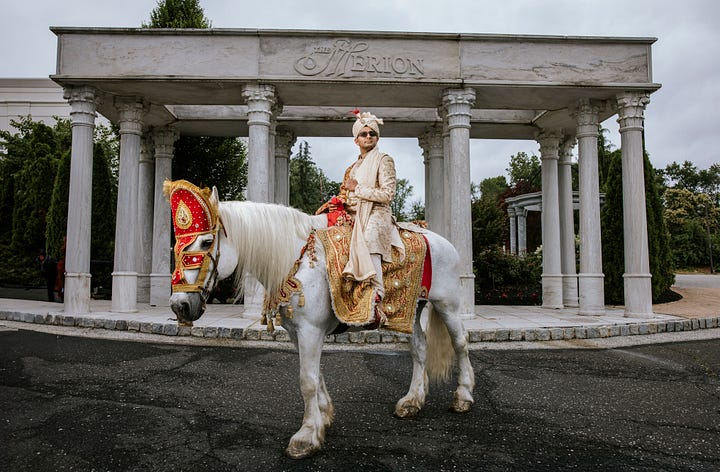
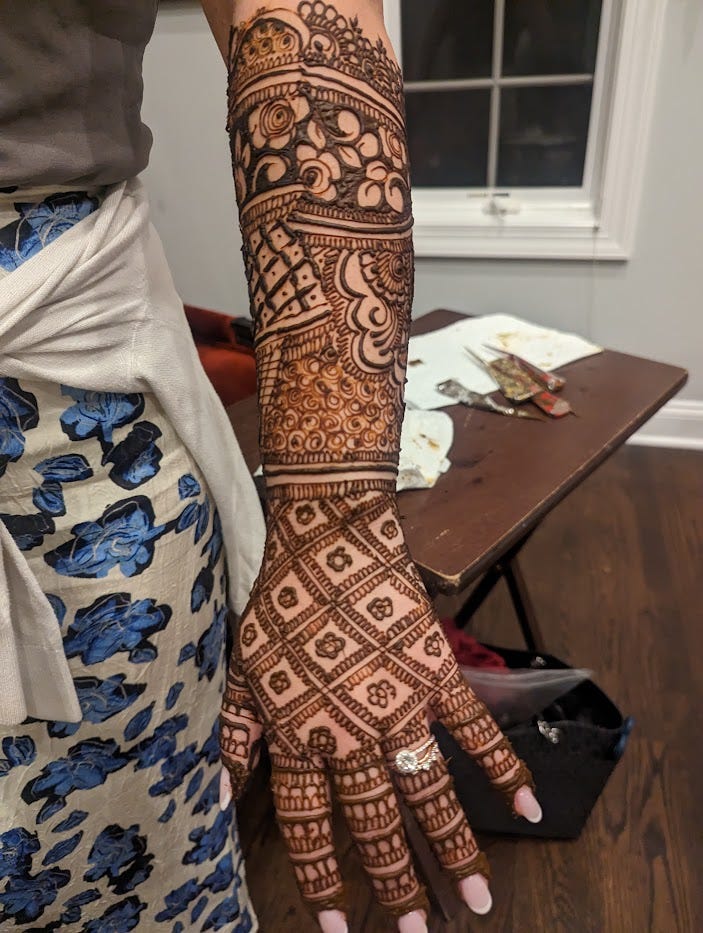
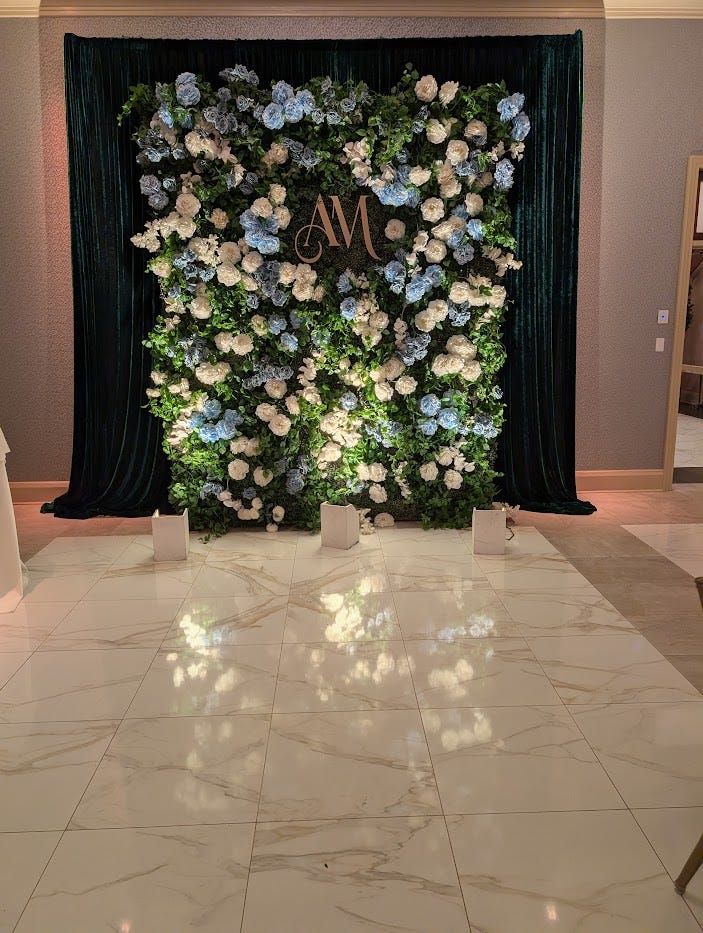
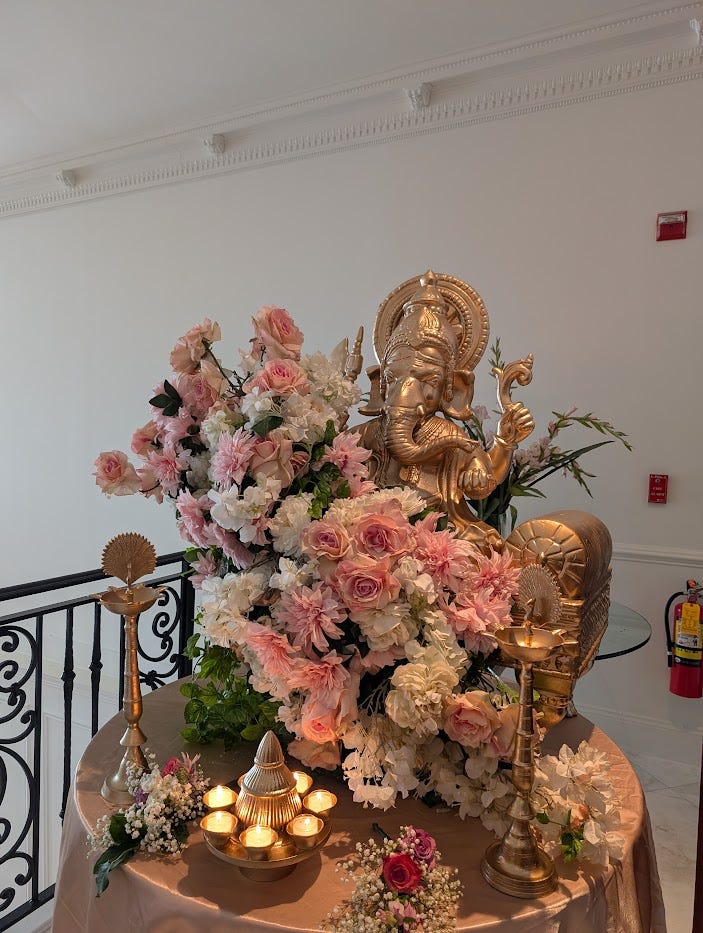
Though, as Mia can attest, I am obviously the trophy husband.
And just forget about anything even remotely sexual. That’s a whole other bag of worms, best left for a PhD in Sociology to dissect.
I think religious leaders can also obviously be quite sketch, see Joel Olsteen. But, still, my experience with my family pandit has been very positive, maybe because it was more intimate than a mega church.
Why does everything have TSA security these days?
I suppose having Agni at the wedding is the mythological version of filing a marriage certificate. As the messenger he'll let everyone else know.
ok I'm exaggerating a bit for the blog. It is legitimately a very good pizza, and may very well be my favorite pizza, but also pizza is very subjective so I don't want to get any angry emails from people who disagree, thanks




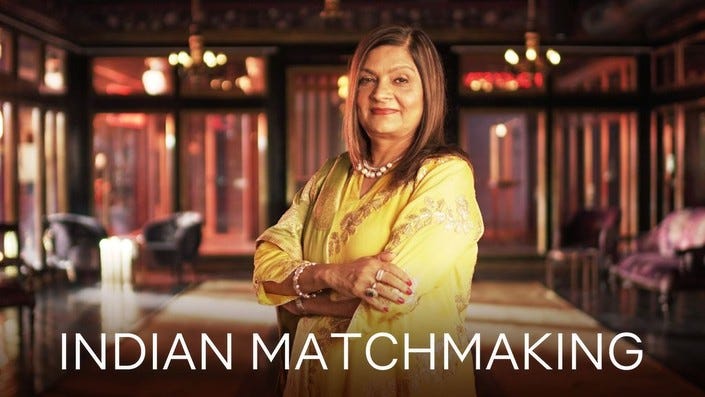



Sincere congrats and best wishes!
You're totally right in terms of spectacle, I think North Indian weddings are definitely the most flashy and interesting and high spirited among all the wedding traditions I've been to.
I've always wondered at the extreme degree of planning and logistics that must go into them - hearing it articulated as a sort of "trial by fire" of the union of how well the two families can cooperate and get things done together is pretty interesting.